|
Panasonic Lumix TS20
At less than half the cost of a top-of-the-line ruggedized camera, this Lumix may be a great bargain, or fall short.
(by Conrad H. Blickenstorfer and Carol Cotton)
To be honest, we had asked Panasonic for their Lumix TS4 to review, and not the TS20. For two reasons: First, ScubaDiverInfo.com had done a detailed review of the Lumix TS2 a couple of years ago and we wanted to see whether Panasonic had addressed the issues we had had with that camera. Second, we had scheduled two extensive diving and outdoor adventure product review trips and wanted to see how the latest Lumix stood up against its tough camera competition from Canon, Nikon and Pentax.
Unfortunately, Panasonic was unable to make a TS4 available and offered the TS20 instead. The TS20 is also a waterproof, shockproof, freezeproof and dustproof camera, but it's waterproof only down to 16 feet whereas "real" waterproof cameras in this class can handle 33 to 40 feet. If you're a diver, that makes a world of a difference. We took the Lumix TS20 along anyway, but repositioned the review to get a feel how the limited depth rating affected the usefulness of the TS20 on adventure trips.
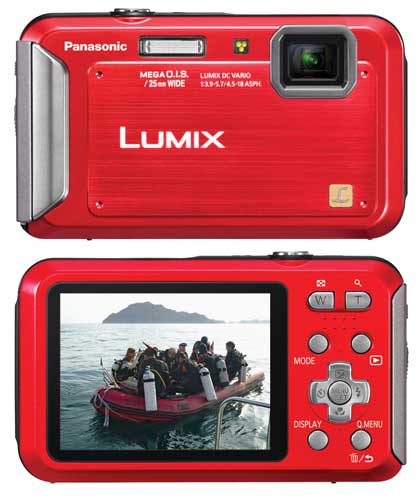
How deep can it go? Why it's important.
Why do we differentiate between cameras that can handle 30 or 40 feet of depth, and those that can only handle 10 to 15 or so? Because that's the difference between a camera that you can take on actual scuba dives and cameras that can only handle snorkeling. If you never go dive, the difference between 10 and 40 feet is irrelevant. If you do dive, it's the difference between being able to take the camera along and leaving it on the boat. But aren't most scuba dives deeper than 30 or 40 feet anyway? Most are, but not all. There are plenty of shallow reefs, and being able to take a handy little camera without a housing down there is priceless.
So if you are not a diver or don't intend to ever take your camera on a dive, whether a camera can handle 10 or 40 feet of depth is of no importance. And you can actually save a good bit of money by not paying for the extra water protection. That's because sealing a complex piece of electronics with as many parts and external controls as a digital camera is quite a task. Take apart a waterproof camera (we have), and you know what I mean. The Lumix TS20 must be able to handle just half the water pressure than a camera designed for 33 feet of depth, so it can be smaller and lighter, and it is. It also costs less than half as much as most of the fully waterproof cameras. The question then becomes whether you're giving up more than just the extra water protection.
What do you get with the Lumix TS20?
While fully waterproof cameras are remarkably small and compact given the abuse they can take, most are a little larger and heavier and larger than your standard superslim digital camera. The Lumix TS20, however, is hardly bigger than any standard slender point & shoot. Measuring just 4.0 x 2.3 inches, its footprint is smaller than that of any modern smartphone. It's a bit thicker (0.78 inches) and heavier (4.9 ounces) than most small smartphones, but for what it can endure out there in the great, wet, dusty outdoors that's a very small price to pay.
The technical specs are what you'd expect from a dedicated camera today, and they are actually not much behind the more expensive deep-diver cameras. In fact, the TS20 offers the same 16-megapixel resolution as the Pentax WG-II and the Nikon Coolpix AW100, and four more than the Canon D20. The 4X optical zoom is a notch shy of the 5X that's now the norm underwater, but it does start nicely wide at 25mm and goes up to 100mm (35mm equivalent). There are 75MB of internal storage, which means there's room for a few pictures even if the SD storage card is full (or if you forget to put a card in). Specs are bit short in the movie department where the TS20 only take 720p (1280 x 720 pixel) video and not the full 1080p (1920 x 1080 pixel) HD format. The display still has the traditional 4:3 aspect ratio, so if you shoot in wide format, pics will be letter-boxed. It's bright enough, but at 2.7 inches smaller than the current norm, and has less resolution (230k pixels).
In terms of controls, the TS20 is simple and easy to use. On the top of the camera is the small, flush-mounted on-off button where it's easily accessible, but you won't mistake it for the shutter and turn the camera off when you want to take a picture. The shutter is large and sticks up a bit, so there's never any doubt as to where it is. Next to it is a small dedicated video button. It's flush-mounted and perhaps a bit too hard to push, especially under water where fingers may be cold or you may wear gloves.
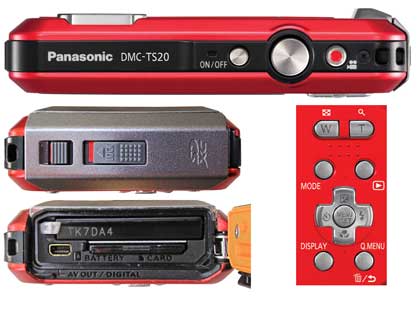
The side views above shows the camera with its sole protective door to the battery/storage card/IO compartment open and closed. The door is secured with a spring-loaded lever and then an additional lock.
The controls are simple: small zoom buttons, push buttons for mode, replay, display and quick menu, and a 4-way navigation pad with an okay button in its center. The four directions of the nav pad double to bring up macro, flash, exposure, and self-timer menus. The only problem here is that the tiny silk-screened icons on the nav pad are very hard to read.
The plastic body with its metal shells back and front (available in black, blue, red or orange) sounds a bit hollow when you tap on it, but it feels sturdy enough. The toughness specs are impressive. The camera is designed to survive 5-foot drops and operate in a wide 14 to 104 degree Fahrenheit temperature range. In that respect it matches the more expensive tough cameras.
Features
While manufacturers generally try to pack as many features as possible into cameras in an effort to make them stand out (or at least not fall behind), the TS20 is fairly basic in the tricks department. Panasonic primarily concentrated on the ruggedness aspect of this camera and kept needless features at a relative minimum.
In terms of modes, there are eight basic recording modes to chose from:
- Intelligent Auto -- the camera decides what settings and mode to use, and briefly displays the icon for the scene mode it has chosen.
- Normal picture -- this is what is usually called program mode, i.e. the camera sets shutter and aperture, but users have limited control over functions (like ISO, white balance, auto focus mode, burst mode, video recording mode, and LCD setting)
- Sport
- Snow
- Beach & Surf
- Underwater (AF lock available)
- Miniature effect
- Scene -- from here users can select from a dozen additional scene modes (portrait, soft skin, scenery, panorama, night portrait, night scenery, food, baby1, baby2, pet, sunset, high sensitivity, glass through)
The TS20 has four zoom modes, ranging from standard optical, to "extra optical" where you can zoom in more without image degradation, but only from smaller picture sizes, to "intelligent" with some degradation, to digital with significant degradation. There's an auto bracketing where the camera takes three shots with different exposure of every picture. There's a very nice panorama mode that does a better job than most. And, of course, there's the ever popular face recognition, including detecting registered faces and entering babies and pets names. That's all great fun, but we'd much rather see features that actually relate to the rough and tough outdoors nature of the camera.
At least Panasonic didn't add endless in-camera editing features as that is best be done on a PC with real image editing software. There'd be more to be said about various minor features (like i-baby, etc.), but few relate to the way we used the camera, i.e. outdoors and in the water.
Power
The Lumix TS20 uses a 680 mAh, 3.6V Li-Ion Panasonic DMW-BCK7PP battery. A full charge is good for about 250 pictures or 90 minutes of 720p movie recording, though that depends on how often you use the LCD and how bright you set it. Replacement batteries are inexpensive and widely available, so I'd get a spare or two. The TS20 comes with an external charger for the battery with built-in prongs (which means you don't have to take a bulky cable along).
Panasonic Lumix TS20 in the Sea of Cortez
Thanks to Panasonic's ever helpful PR team, we had a chance to take the Lumix TS20 along on a 7-day dive and exploration trip through the Midriff islands of the Sea of Cortez aboard the good ship Rocio Del Mar. We felt that was a great way to see how well the tough Lumix performs under the often demanding conditions on a scuba diver live-aboard. Note that all pictures in this review (except for the ones with the Lumix in it) were taken with the TS20.
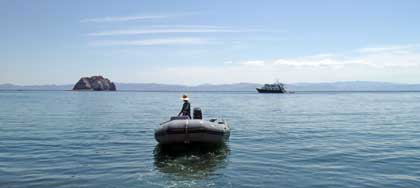
As it turned out, above water, the TS20 managed to holds its own against the more expensive competition, but the 16-foot depth limit meant it was usually left behind on our daily dive expeditions. So while the small Lumix proved to be an exceptionally handy companion for this type of wet and salty adventure, it saw less action than the others. We did, however, count on the little red Lumix in the sand, on beaches, on Zodiacs, and snorkeling.
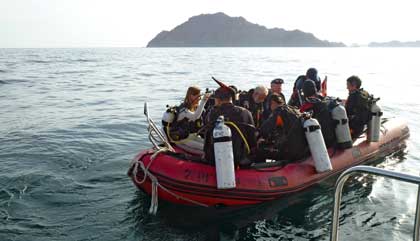
The Sea of Cortez itself (which the Mexican government officially renamed the Gulf of California) is about 800 miles long, between 30 and 150 miles wide, and has an average depth of almost 2,700 feet. Also known as the Islas Grandes, the eleven Midriff islands are located in the upper third of the Sea of Cortez. All are uninhabited and there's a haunting, stark beauty to them.
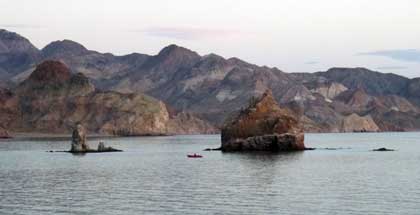
While we didn't dive in the Sea of Cortez with the Lumix, we always had the TS20 with us when snorkeling. For example, we took it along swimming and snorkeling with whale sharks in the Bahia de los Angeles, a coastal bay on the eastern shore of Baja California. The almost fully enclosed bay is part of a biosphere reserve, and we came here to see whale sharks. Whale sharks are filter feeders and the largest living fish on the planet. They can be over 40 feet in length, weigh almost 40 tons, and go back some 60 million years. They pose no danger to divers and snorkelers, and they can be observed as they are slow swimmers. The picture below is a screen grab from 720p HD video we took of the whale sharks.

The Lumix was perfect having around the boat because it is so small and handy, and because we obviously never had to worry about it getting wet. As a result, we managed to get a number of great shots of bottlenose dolphins when they suddenly appeared out of nowhere.

Panasonic TS20 in Cancun/Isla Mujeres
We got some great pictures and good video off the Lumix in the Sea of Cortez, but we still felt we hadn't really explored the full potential of the camera since we had to leave it on the boat during all of our scuba dives. So we took it on another product review trip to get some more time with it, both above and under water. Taking beauty shots of the spectacular Riu Palace Resort in Cancun (that's its pool below), of course, was not a challenge for the competent little Lumix.

A big test came when the Lumix accompanied us on a boat ride that took us way out onto the open ocean to a large pod of whale sharks. The boat held ten snorkelers, but only two could be in the water with the sharks at the same time. While whale sharks swim at a leisurely pace, you still have to fin furiously to keep up with them. Here, the small size and ease of use of the Lumix came in handy.
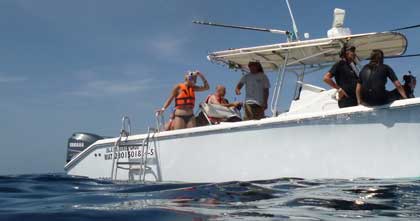
The water conditions off Isla Mujeres were quite different from the Sea of Cortez, with much more light, much warmer water, and more sharks than we'd ever seen. This meant that we simply pushed the shutter or video button instead of trying to mess with settings in the murkier waters in the Sea of Cortez. The picture below shows the way you most often see a whale shark, with the majestic fish slowly pulling away from you.

How well did Panasonic do with the Lumix TS20?
On the plus side...
- Tough enough. The Panasonic Lumix TS20 really doesn't look much different from your average slender point & shoot, but it is. The camera can handle 5-foot drops. Though no one means to drop a camera, it happens, and especially out there in the field. It's good to know the Lumix can handle it. We also like the wide operating temperature range, which is likely even wider than Panasonic specifies as I'm pretty sure it can take pictures past its 104 degree Fahrenheit maximum.
- Folding 4X zoom. You don't really need zoom underwater, but above water the 4x optical zoom gets you just a little closer than a standard 3x. It is also very helpful, both on land and underwater, that the zoom starts wide at 25mm, which comes in handy in cramped spaces.
- Good pictures. We also expect good picture quality from Panasonic, and in general we got them. That said, by just letting the camera pick its own settings at times resulted in slightly flat or off-color pictures that needed post-processing to bring out the right color and contrast.
- HD video and video modes. The TS20 can shoot in 720p 30fps video. Yes, it's "only" 720p and not 1080p, but truth be told, on most flatscreens you can hardly tell the difference. And we liked the dedicated video button.
- Price. The TS20 lists at US$179, and at the time of this writing (mid-October 2012), Panasonic offered it at US$149. That's less than half of the cost of most tough cameras in the 33-40 depth rating class, but you still get a 16mp camera that's just as tough.
- Build quality. The TS20 is light, but tougher than it looks. After several weeks of hard use, there were no scratches, dents or dings.
- Underwater shooting mode. As you'd expect, the camera has an underwater shooting mode that corrects color in underwater conditions.
- Quick and handy. The camera locks onto subjects quickly. This is important underwater where things tend to move around a lot. Switching between normal and macro modes was quick and easy, and so was switching between flash modes.
Things we weren't so crazy about...
- Not a real dive camera. While the TS20 is waterproof, the 16 foot depth limit keeps it from being a real dive camera. You can take it on very shallow reefs, but most dives will be deeper, and you don't want to risk being left behind because you can't follow the group into deeper waters.
- Small buttons. The good news is that all buttons are in a very standard layout and relatively widely spaced. But for an outdoor/underwater camera, the buttons are quite small and hard to operate with cold fingers or gloves.
- LCD. Only a few years ago, the TS20's 2.7-inch LCD with its 230k pixel resolution would have been considered fabulous. Today, it's the camera's weakest point. Between the low resolution and the display's narrow horizontal viewing angle and very narrow vertical viewing angle, it was often hard to see anything.
- No housing available. For deeper dives, some of the competition offers an optional deepwater case. None is available from Panasonic for the TS20 (Ikelite, though, has one).
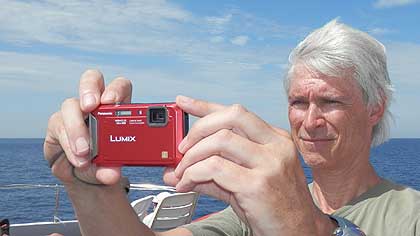
Bottom line: Panasonic Lumix TS20
The Panasonic Lumix TS20 is a waterproof, shockproof, freezeproof and dustproof camera built to a price. It only costs about half as much as a top-of-the-line tough compact and can therefore be quite a bargain — depending on what you need and expect from a ruggedized camera.
In terms of toughness and protection from the elements, the TS20 doesn't give up much compared to the top-of-the-line models. It can handle five-foot drops, freezing weather, and it is dustproof and waterproof, just like them. Except that it's waterproof only to 16 feet, which means it's pretty much out for scuba.
You do, however, get the same 16-megapixel resolution as the class leaders, and there's HD video, albeit only 720p and not 1080p. The optical zoom is 4X and not 5X, but it starts wide, which is almost always a plus outdoors and in the water. And it all comes in a smaller, lighter package than the more expensive rugged cameras. The TS20 is simple to learn and operate, and it has enough features for those who like to play with a camera. Particularly nice is its panorama mode. Picture quality was very good.
The much lower price, however, means no GPS, no manual modes, and while the smallish 2.7-inch LCD is bright enough, its lower resolution and inadequate viewing angle make it by far the weakest part of the TS20.
Overall, with a list price less than half that of Panasonic's own Lumix TS-4, depending on your outdoor needs and requirements, the TS20 may be a terrific bargain or it may fall short in critical areas. S, in summary...
We like:
- Nice all-weather camera: waterproof, dustproof, drop-proof, can shoot in freezing weather
- Great price for what the camera offers
- Simple, nicely spaced controls
- 720p HD video, and dedicated video button
- Good picture quality
- 4X optical zoom that starts wide
Not so much:
- Low-res LCD with very narrow viewing angles
- Some controls rather small and hard to operate in adverse conditions
- Only one underwater still setting, no underwater video setting
- Video soft underwater
- No underwater manual white balance or adjustments
- No optional deepwater housing from Panasonic (Ikelite makes one)
See the Panasonic Lumix TS20 web page.
|










